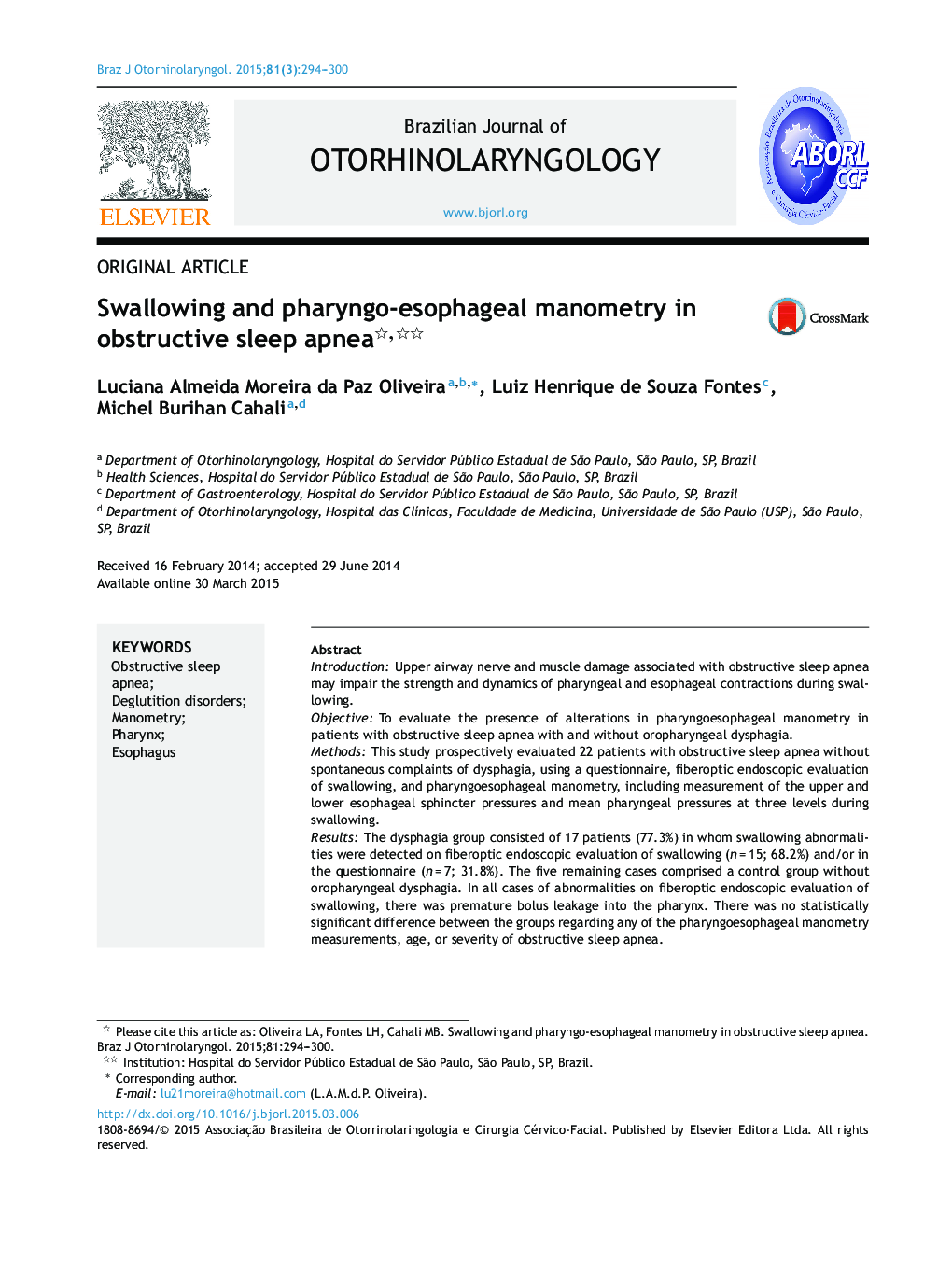| کد مقاله | کد نشریه | سال انتشار | مقاله انگلیسی | نسخه تمام متن |
|---|---|---|---|---|
| 4106240 | 1605367 | 2015 | 7 صفحه PDF | دانلود رایگان |
IntroductionUpper airway nerve and muscle damage associated with obstructive sleep apnea may impair the strength and dynamics of pharyngeal and esophageal contractions during swallowing.ObjectiveTo evaluate the presence of alterations in pharyngoesophageal manometry in patients with obstructive sleep apnea with and without oropharyngeal dysphagia.MethodsThis study prospectively evaluated 22 patients with obstructive sleep apnea without spontaneous complaints of dysphagia, using a questionnaire, fiberoptic endoscopic evaluation of swallowing, and pharyngoesophageal manometry, including measurement of the upper and lower esophageal sphincter pressures and mean pharyngeal pressures at three levels during swallowing.ResultsThe dysphagia group consisted of 17 patients (77.3%) in whom swallowing abnormalities were detected on fiberoptic endoscopic evaluation of swallowing (n = 15; 68.2%) and/or in the questionnaire (n = 7; 31.8%). The five remaining cases comprised a control group without oropharyngeal dysphagia. In all cases of abnormalities on fiberoptic endoscopic evaluation of swallowing, there was premature bolus leakage into the pharynx. There was no statistically significant difference between the groups regarding any of the pharyngoesophageal manometry measurements, age, or severity of obstructive sleep apnea.ConclusionPharyngoesophageal manometry detected no statistically significant difference between the groups with and without oropharyngeal dysphagia.
ResumoIntroduçãoLesões neurogênicas e musculares associadas à apneia obstrutiva do sono podem comprometer a força e a dinâmica das contrações faríngeas e esofágicas durante a deglutição.ObjetivoVerificar se há alterações na manometria faringoesofágica de pacientes com apneia obstrutiva do sono com e sem disfagia orofaríngea.MétodoForam avaliados, prospectivamente, 22 pacientes com apneia obstrutiva do sono sem queixa espontânea de disfagia, utilizando questionário, videoendoscopia da deglutição e manometria faringoesofágica, com medidas das pressões do esfíncter esofagiano inferior e superior e pressão média da faringe em três níveis durante a deglutição.Resultados17 pacientes (77,3%) formaram o grupo com disfagia, por apresentarem alterações de deglutição na videoendoscopia da deglutição (n = 15; 68,2%) e/ou no questionário (n = 7; 31,8%). Os cinco restantes compuseram o grupo sem disfagia orofaríngea. Em todos os casos com alterações na videoendoscopia da deglutição houve escape precoce do bolo alimentar para a faringe. Não houve diferença significante entre os grupos com e sem disfagia em relação a todas as medidas de manometria, idade e gravidade da apneia obstrutiva do sono.ConclusõesA manometria faringoesofágica não demonstrou diferença significante entre os grupos com e sem disfagia orofaríngea.
Journal: Brazilian Journal of Otorhinolaryngology - Volume 81, Issue 3, May–June 2015, Pages 294–300
